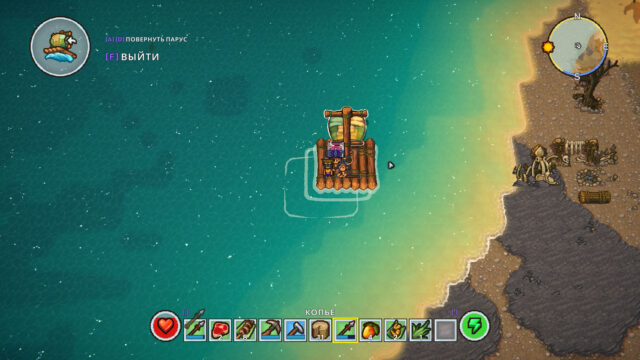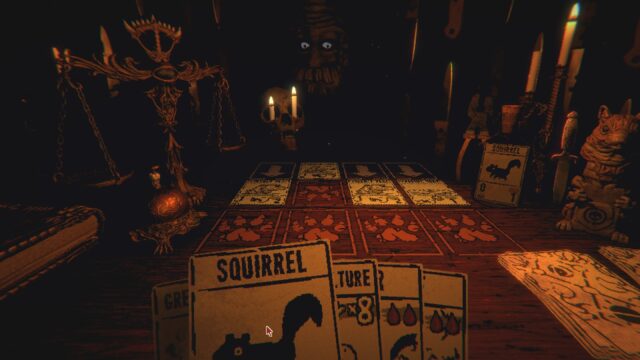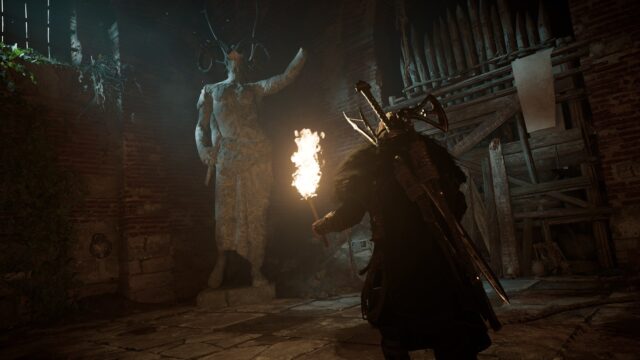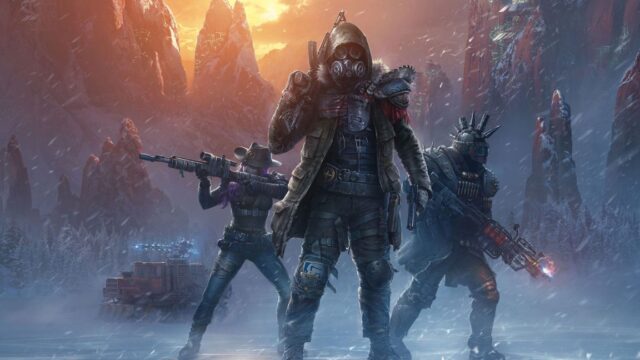Tomb Raider Review
Follow me, young adventurers. However, if you remember the first Tomb Raider games, we can do without the word “young”. Down, descending through narrow corridors, bypassing huge stone gates, into a hall illuminated by torchlight. Step carefully – for this is the place where fallen video game heroes rest.
Here lies BloodRayne, buried in her finest leather attire. Over there – marked by a giant tattered suspender – is the tomb of Leisure Suit Larry. Further on lie the petrified remains: Gex the gecko, Bubsy the lynx, and Q*bert… whoever he may be. Fallen warriors. Let us honor their memory with a minute of silence – let the silence be broken only by the sounds of Nintendo wielding shovels and… Sega is messing around with corpses. Unthinkable things.
Now let’s take a look at the sarcophagus with the thinnest layer of dust and move the lid. Digging through the decaying bones, we will find a couple of pistols, 47 medkits, and a bra capable of holding a couple of watermelons. Lara Croft rests here – she is deader than the first bat she shot in the head.
Wipe away the approaching tears. Lara holds a special place in the hearts of many of us. She shaped a whole generation of female gamers, for whom Tomb Raider became the gaming equivalent of the novel “Under the Glass Bell”. From this point of view, T-Rex even slightly resembles Ted Hughes.
But it is time to let go of the old Lara. Characters must evolve, series must move forward. After all, what awaits us otherwise? A stagnant culture, where creative expression suffocates under the weight of tiresome nostalgia and decaying ideas.
So, it is quite understandable that the developers of Tomb Raider, Crystal Dynamics, decided to try something new. As known from press releases, filled with words like “reboot,” “boldness,” and “where it all began,” the franchise is getting a new life. It is a kind of prequel, explaining how Lara transformed from an ordinary young girl into a tough female who beats up sharks. They could have named the game: “Lara Croft: How Time Changes People.”
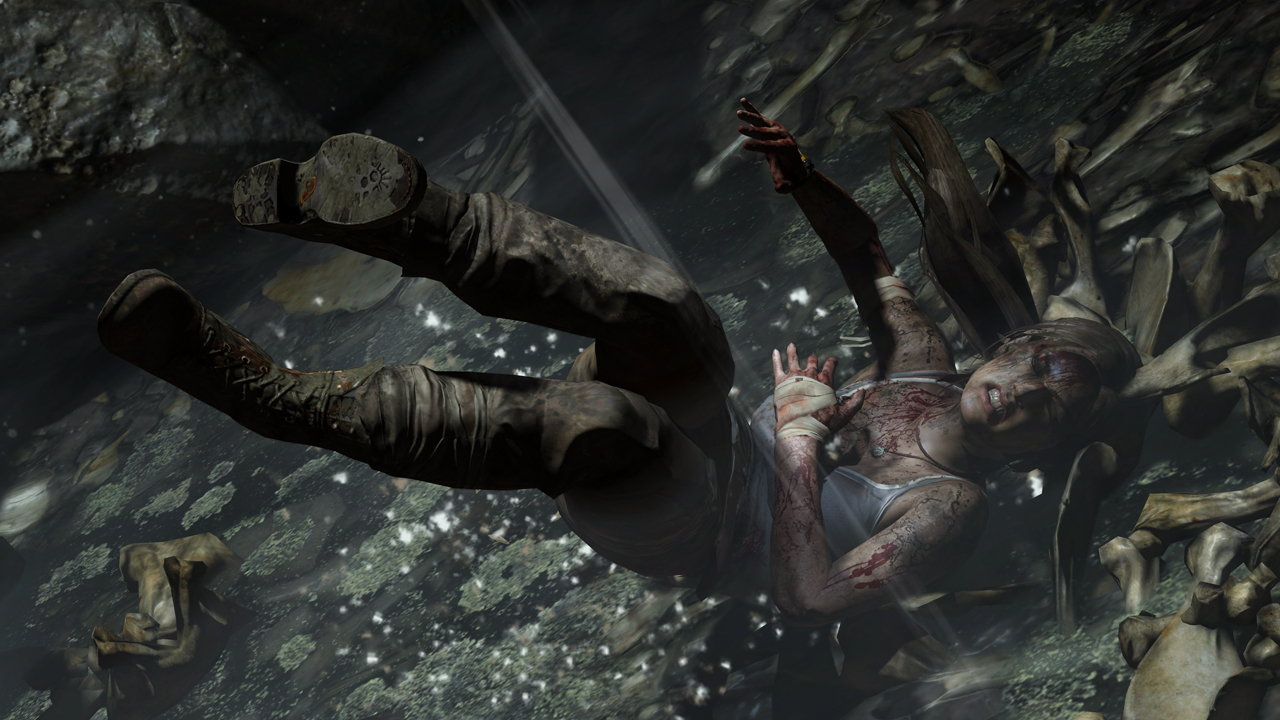
After the question “So, how’s the game, is it okay?” people usually ask: “Can you punch sharks in the face there?”
The setting of the game is a mysterious island filled with mysterious inhabitants, mysterious caves, mysterious tombs, mysterious artifacts, and mysterious crates. Lara regains consciousness after a shipwreck, in the company of disfigured corpses and without any means at her disposal.
The introduction is quite boring – and also a bit awkward. Because of the sounds Lara makes, neighbors might think you’re watching kinky porn. When she’s not screaming, squealing, panting, or moaning, she’s constantly being chased and grabbed. When Lara dies, her cries sound like a horribly simulated orgasm.
And all of this takes place against the backdrop of mutilated bodies and ritual sacrifices. There are no spoilers here: all of this is present right from the beginning – there is no build-up to something terrifying. The bloody scenes are so vivid and frequent that they soon cease to scare or shock. “Well, well,” Lara would say if she constantly voiced her thoughts, “another room with skinless corpses and a sea of blood. I wonder what’s in that crate?”
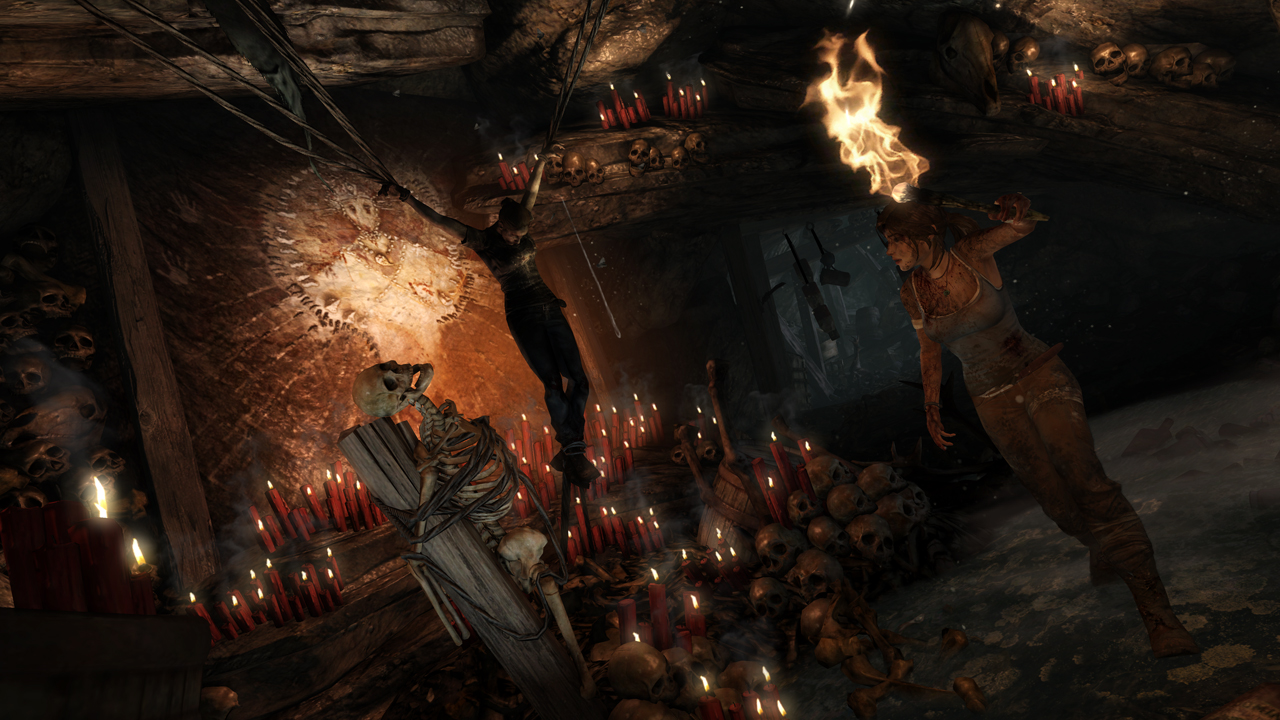
According to the agreement with Square Enix, we do not have the right to confirm or deny the possibility of punching a shark in the face.
Fortunately, she is not as inclined to think out loud as some (yes, Alan, I’m talking about you). The character of Lara is more developed through dialogue, and she comes across as sweet and believable. If we ignore all her screams, the writers did a good job creating a woman with immense inner strength, yet genuinely concerned about the dangers that await her.
It’s a shame that other characters don’t appear on screen often, and as a result, they fail to go beyond archetypes like the Energetic Black Woman, the White Botanist, the Hot Asian, and the Dirty Violent Person of Indeterminate Baltic Appearance. The plot unfolds at a decent pace, and the dialogues serve not only to explain what’s happening. However, it seems that two forces collide here – the story that wants to be told and the gameplay that wants to prove to everyone that it does exist.
The most vivid example is Lara’s first kill at the beginning of the game. The short scene shows us how she realizes the weight of taking a human life, how she understands that once she crosses that line, there’s no going back. The pathos of this moment is slightly diminished over the next ten minutes when Lara, without hesitation, takes down everything in her path.
The heroine completely forgets about her conscience within a few hours, easily dispatching enemies with an improvised pickaxe – usually aiming for the head. Excessive violence in video games has become a familiar norm, but here it feels out of place, as the plot tries to present everything more subtly and realistically. However, despite all its efforts, Lara’s transformation from an innocent girl into a killing machine happens without any significant moral dilemmas.
Combat will remain the dominant component of the game, but fortunately, it will change in other aspects. Over time, the rivers of blood become less turbulent, and Lara screams much less. There are excellent stages with exploration, beautiful views, and atmospheric tombs. The latter can be found by deviating from the main route, and solving puzzles in them is purely voluntary.
It’s a great idea. Many puzzles are as challenging as in old games, but they can be bypassed without getting stuck for hours, like with a key and a dead monkey in Tomb Raider 3. Just like in any other place in Tomb Raider 3.
There aren’t many mandatory puzzles, and they are not very difficult. Ropes are often used in them. At the beginning of the game, one might think that the main element of the series has been given a disappointingly small role. But again, everything changes as you progress: the puzzles become harder and more frequent. It immediately brings back memories of the good old times, as long as the game calms down, falls silent, and allows Lara to take a deep breath and contemplate the solution.
Unfortunately, after every beautiful view or challenging moment, we are greeted with another drawn-out battle with cover and shooting. It’s as if the game is afraid that the poor player’s brain will tire from intense deliberations about opening a door and presents them with meaningless violence as a sedative.
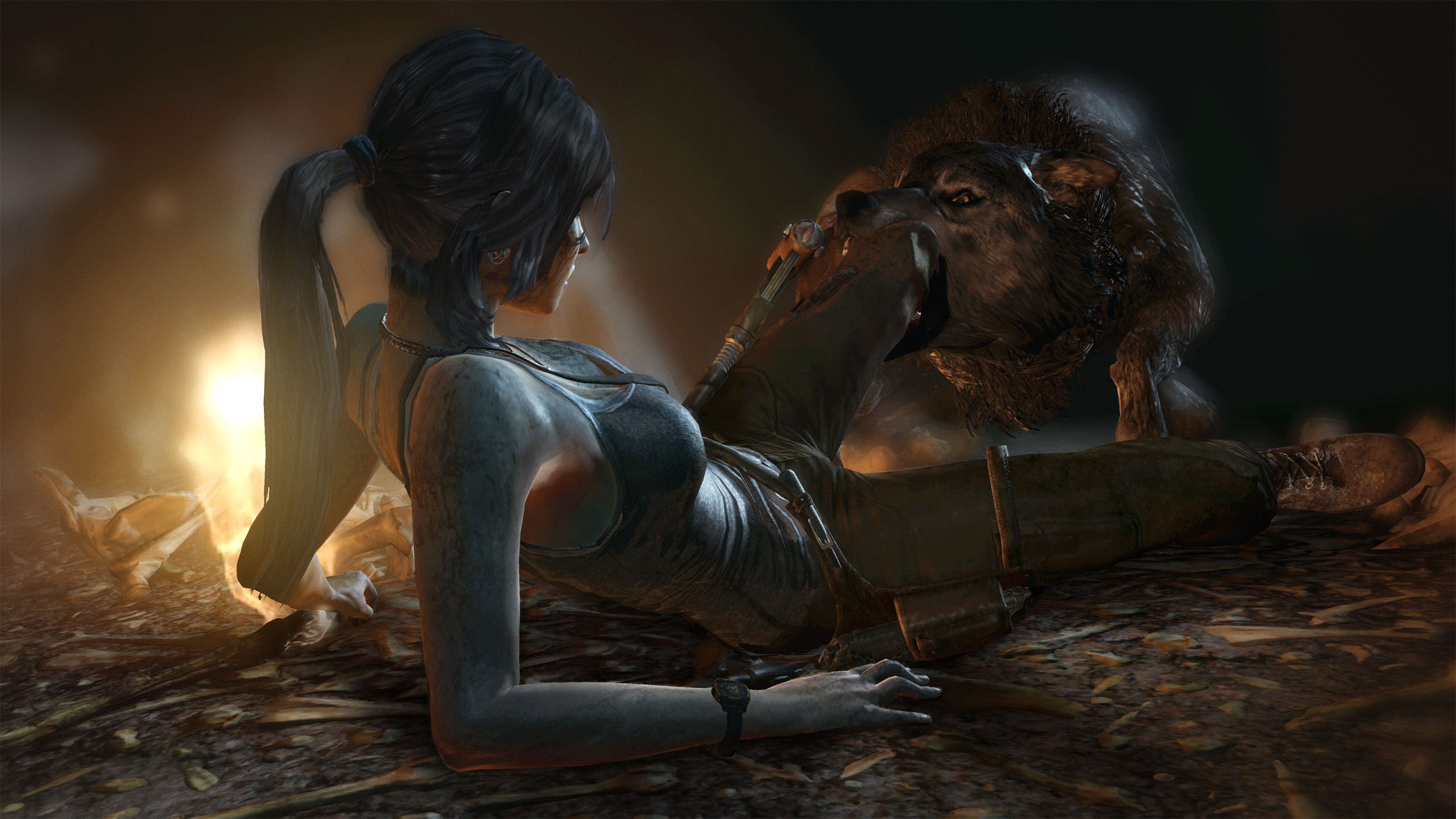
The local wolves resemble both the Hound of the Baskervilles and Gnesher.
And the game clearly worries that the player doesn’t have enough activities and constantly bombards them with useless tasks like “Find all the vases!”, “Collect all the mushrooms!”, “Burn all the flags!”. There are so many diary pages and various collectible objects here that the island looks like a dump, where the most boring museum in the world throws away even the exhibits it doesn’t need.
Neither the multitude of menus storing information about these objects, nor the endless messages on the screen help the situation. Capital letters and exclamation marks won’t make me happy about the inscription “FOUND 2 OUT OF 3 CEREMONIAL VEERS!”. And I won’t regret the “0% VASES” in the final score (although I’m proud of the achieved “67% KANPO GRASS”).
It is quite possible that there are players who simply need to open every box. And someone, on the contrary, will complete the whole game without bothering with it at all. But because of the abundance of scattered trinkets on the island, it is difficult to ignore them, and they start to annoyingly distract.

Lara constantly loots the killed enemies in search of ammunition, but for some reason doesn’t take any clothes. Even when it’s snowing.
How distractions and rewards that the game carefully overwhelms us with. At an early stage, there is a moment when Lara escapes from a collapsing cave. At the last moment, she is saved, and she meets an island, in all its harsh beauty, illuminated by rays of sunlight breaking through the clouds. The orchestra in the background makes this moment of liberation and relief even more beautiful – but they manage to spoil it with an on-screen message “ART GALLERY OPEN MAIN MENU/EXTRA”.
And this happens very often. It’s like sitting in a restaurant and trying to enjoy a delicious lunch, while the waiter stands next to you and constantly chatters something like, “Oh, I see the sauce pleased you. If you’d like to visit the kitchen, the chef has prepared a small presentation in Power Point on how the dish is prepared.”
When the game doesn’t shove you into art galleries, it uses everything that falls into the player’s field of view in a desperate attempt to please them. Experience, “Skill Points,” weapon upgrades, “Salvage” (in-game currency used to purchase upgrades). It’s hard to keep track of all this nonsense, and even harder to consider it useful. I’m not going to spend points on an upgrade that gives me a leaf icon. I’m too old for Boy Scouts.
An additional sentence that gets rid of additional sentences – that’s multiplayer. It’s great. There are several modes, all of them variations on old themes. The maps are well thought out, with lots of hiding spots and alternate routes. Everything works as it should, just like in dozens of other games. The only problem is that the multiplayer doesn’t fit into the theme and seems unnecessary in this already overly bloated game: 54 layers of icing crack under the weight of seven thousand cherries.
Undoubtedly, game series need development. Otherwise, we wouldn’t have seen Mario 64, Prince of Persia: The Sands of Time, or Jambo Safari Wii. The problem is not that Tomb Raider is trying to do something new. The problem is that it’s doing the same thing as everyone else.
And in this, the game succeeds. Checkmarks are ticked in every field, sometimes even multiple times: collectible items, upgrade system, big guns, blood, graphics, bosses, dialogues where lip movements almost match the speech, multiplayer, art galleries, QTE, other collectible items. And all of this is done at a high level of quality.

4, 8, 15, 16, 23, 42.
But all of this is just tricks to attract attention, behind which the true advantages of Tomb Raider are hidden. Beneath all the fuss, there is a captivating story and moments of true beauty, tranquility, and inspiration, desperately trying to be seen and heard. The longer you play, the better the game becomes, and despite the annoying gimmicks, the last hours are enjoyable. The delightful main heroine remains an icon – but now more human and believable than ever.
So, farewell, old Lara, your time is up. Hello, new Lara. Don’t kill anyone for at least five minutes, and we’ll be friends.
Share
Discuss
More Reviews

